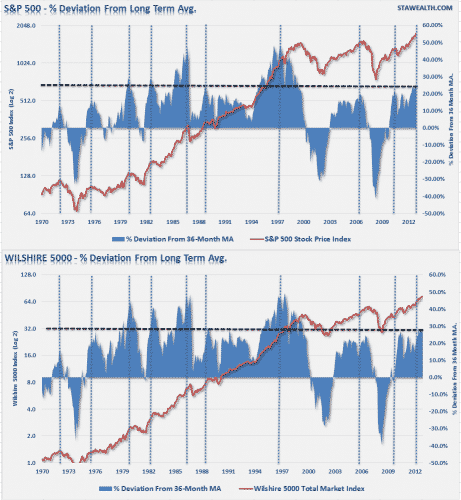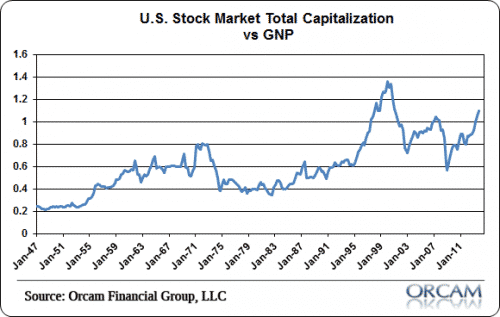US stock market capitalization higher than any time except NASDAQ bubble
I recently posted an article posing the question of whether, or not, the markets had entered into the “3rd Stage Of A Bull Market?” In the article I stated:
“Are we in the third phase of a bull market? Most who read this article will immediately say “no.” However, those were the utterances made at the peak of every previous bull market cycle. The reality is that, as investors, we should consider the possibility, evaluate the risk and manage accordingly.”
During the radio program last night I was discussing the long term trends of the market and discussing the deviations from the long term moving averages. Moving averages are like “gravity” to stock prices. The farther away (deviation) from the moving averages that prices get; the greater the probability becomes for a reversion back to the mean. The chart(s) of the day is a monthly analysis of the S&P 500 Index and the very broad Wilshire 5000 Index from 1970 to present.
It is worth noting that currently both markets are pushing deviation extremes only seen four times previously. The difference has much to do with the “secular market” within which these deviations occurred. The deviation extremes were much shorter lived during the secular “bear” market of the 70’s which effectively ended in 1982. With interest rates and inflation falling the secular “bull” market of the 90’s, combined with the “irrational exuberance” of the “tech bubble”, the markets were able to sustain extreme deviations from the long term average for an extended period. Ultimately, however, those extremes have always been reversed.
The current deviation from the long term average, fueled by Federal Reserve interventions, is approaching extremes in both deviation and duration. As I stated above – as investors we should always remain mindful of the risk.
My friend Cullen Roche, Pragmatic Capitalist blog, picked up on an additional concern that had also caught my attention:
“I have to admit that I start to feel a bit uneasy about things when I see all news reported as good news because it either means the economy is getting better or more QE is coming. That wouldn’t bother me so much if corporate earnings were still booming and the economy was growing strongly, but neither one is occurring. In fact, the market is just driving higher on what looks like sheer optimism of continued QE; and little else.
You can see this optimism in two indicators you’ll recognize. The first is Warren Buffett’s favorite valuation metric – total market cap to GNP. The latest reading of 110% has only been surpassed by the Nasdaq bubble.
I’ll be honest – I’ve never really understood the obsession with equities and being a macro guy I probably never will because I have so much love for so many asset classes and approaches. But if I were 100% allocated in equities at this point in the cycle I would feel rather uneasy about my positioning.”
Read more at https://pragcap.com/2-charts-that-make-me-feel-uneasy-about-the-stock-market#YzptZUSxhcPmXPUA.99
I agree with his concerns, and this is something I addressed previously in “There Is No Asset Bubble?”
“While it is certainly conceivable that the markets could attain all-time highs. The speculative appetite, combined with the Fed’s liquidity, is a powerful combination in the short term. However, the increase in speculative risks combined with excess leverage leave the markets vulnerable to a sizable correction at some point in the future.
The only missing ingredient for such a correction currently is simply a catalyst to put “fear” into an overly complacent marketplace.
In the long term, it will ultimately be the fundamentals that drive the markets. Currently, the deterioration in the growth rate of earnings and economic strength are not supportive of the speculative rise in asset prices or leverage. The idea of whether, or not, the Federal Reserve, along with virtually every other central bank in the world, are inflating the next asset bubble is of significant importance to investors who can ill afford to lose a large chunk of their net worth.
It is all reminiscent of the market peak of 1929 when Dr. Irving Fisher uttered his now famous words: “Stocks have now reached a permanently high plateau.”
Does an asset bubble currently exist? Ask anyone and they will adamantly say ‘NO.’ However, maybe it is precisely that tacit denial which might be an indication of its existence.”


Comments are closed.